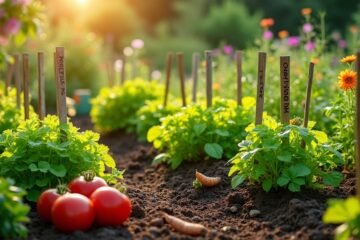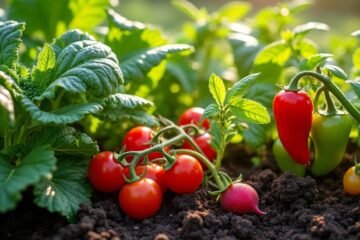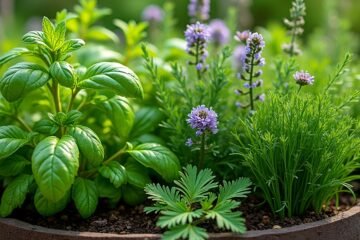Want to turn your tiny space into a flourishing garden? Vertical container gardening’s the trick! Choose stylish containers—think terracotta or bright plastic—and fill ’em with climbing veggies like indeterminate tomatoes and twirly pole beans! Mix 50% potting soil with a dash of compost and perlite for magic growth. Water smartly with a drip system, and watch those vines creep up like enthusiastic children! Keep going to discover more tips for an abundant harvest in your own green paradise!
Benefits of Vertical Container Gardening
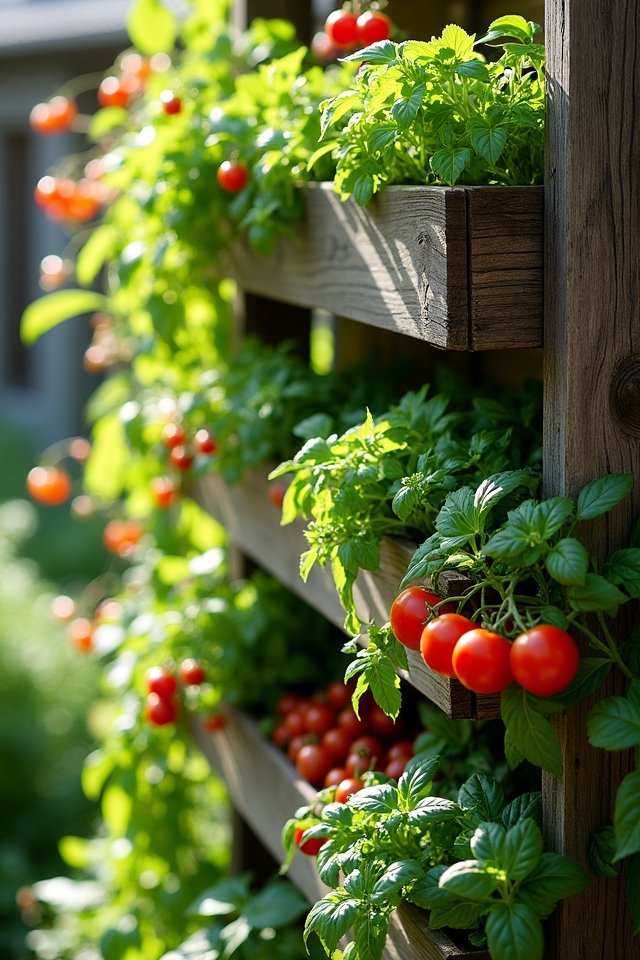
When it comes to maximizing space in your garden, vertical container gardening is like discovering hidden treasure! You’ll marvel at how this innovative approach enhances space efficiency in your urban gardening endeavors. Picture lush tomatoes cascading down from a wall, or vibrant herbs sprouting joyfully in neat rows. Not only do you make the most of your limited area, but you also create visual interest that’s sure to impress your neighbors. Plus, you’ll have less back pain from bending over! Imagine harvesting fresh produce right outside your door, all while saving precious ground space. It’s a win-win situation! So, why not adopt this exciting method? Your green thumb will thank you, and your home will turn into a breathtaking garden oasis!
Choosing the Right Containers

Choosing the right containers for your vertical garden can be as exciting as picking the perfect outfit for a night out! You want something stylish yet functional. First, think about container materials—plastic is lightweight and won’t break your back, while terracotta adds a rustic charm but can be heavy. Next, consider container size: make sure it fits your space and the plants you want! Overly small containers can suffocate roots, like trying to squeeze into those too-tight jeans! Aim for depth; a container around 12 inches deep works wonders for root growth. Remember, the right combination of materials and size can turn your vertical garden into an innovative space that’s both beautiful and bountiful. Get creative, and let your garden shine!
Selecting the Best Vegetables for Vertical Growth
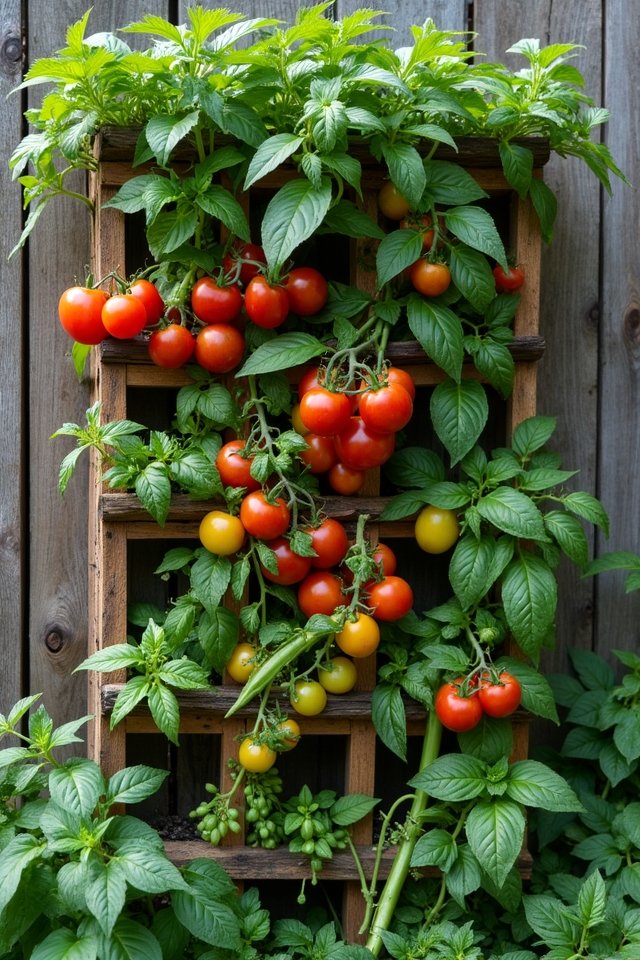
Now that you’ve got your containers sorted, it’s time to pick the stars of your vertical garden—the vegetables! Focus on climbing plants; they’re the superheroes of vertical growth! Consider varieties like indeterminate tomatoes, which reach for the sky, or peppy pole beans that twirl up trellises with delight. Don’t forget the luscious cucumbers; their cascading vines can paint a beautiful picture! Try compact varieties of summer squash for that added pop. These vegetable varieties not only save space but create an abundant harvest that’ll make your taste buds dance! Remember, it’s about mixing these bold flavors and vibrant greens to craft a culinary masterpiece right from your outdoor oasis. Ready to let your garden dreams soar? Let’s get growing!
Ideal Soil Mix for Container Gardening
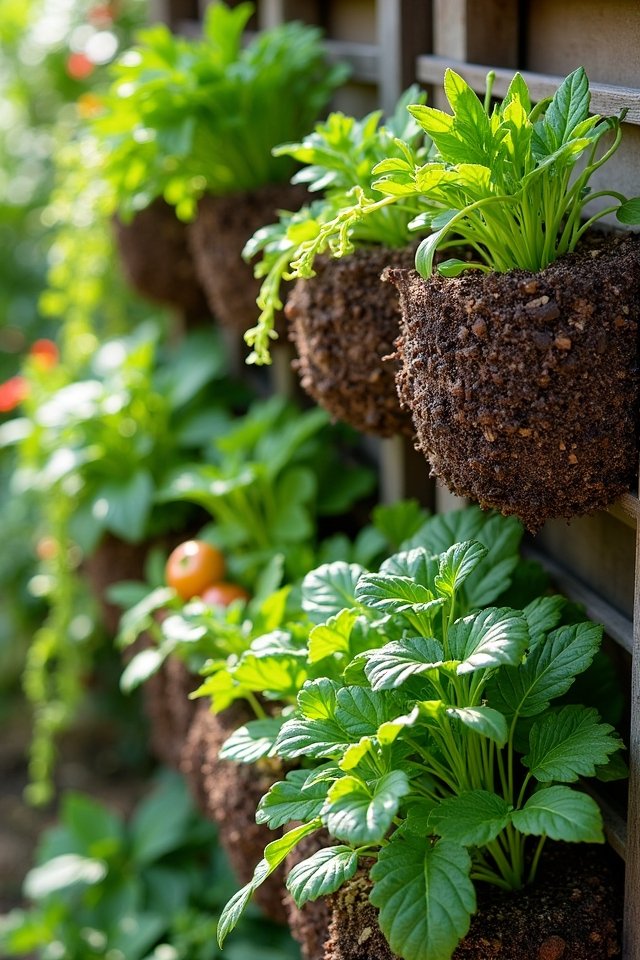
As you roll up your sleeves and dig into container gardening, let’s talk about the magic mix that’ll make your plants flourish! The right soil composition is the potion for thriving veggies. You need a blend that balances nutrients, boosts airflow, and promotes effective drainage techniques. Here’s a foolproof recipe for your soil mix:
- Potting soil – 50% as your base for essential nutrients.
- Compost – 30% to enrich with natural goodness and promote growth!
- Perlite or vermiculite – 15% for excellent aeration and drainage.
- Coarse sand – 5% to prevent compaction and guarantee your roots breathe.
Combine these ingredients for a lively, productive garden! Now, go get your hands dirty! 🌱
Essential Tools and Supplies for Vertical Gardening
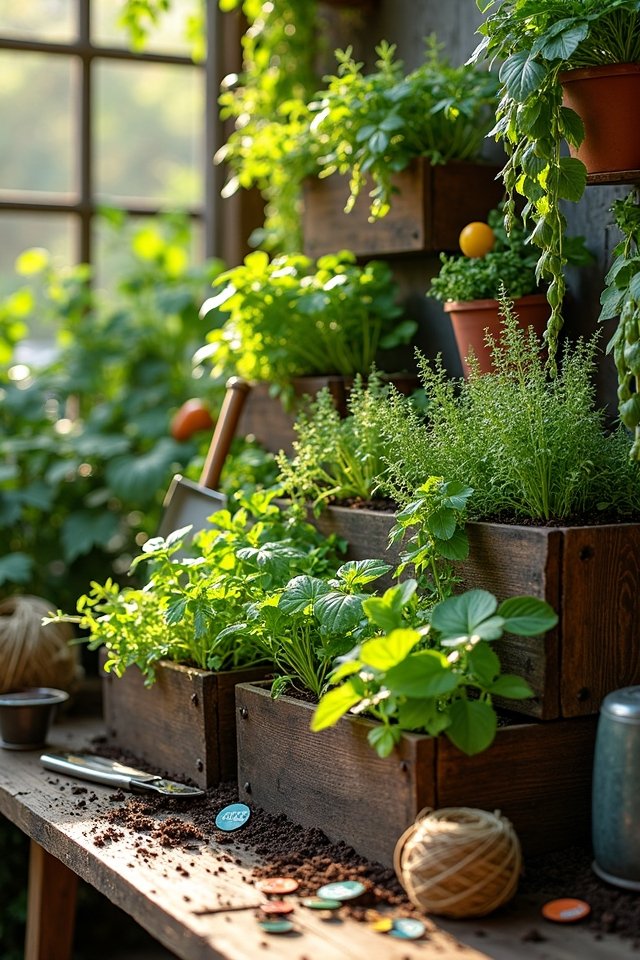
When it comes to vertical gardening, having the right tools is like equipping a superhero for their next mission! To release your gardening potential, you’ll need a sturdy trellis, innovative vertical planters, and quality container materials. Opt for lightweight options like fabric pots or repurposed pallets that enhance airflow and drainage. Mastering various planting techniques, like layering or stacking, will make the most of your garden space! Don’t forget your trusty hand tools—trowels, pruners, and gloves are essential sidekicks in this vertical adventure. Consider a drip irrigation system to help keep your heroes hydrated! With the right gear in hand, you’ll be on your way to creating a dazzling, space-saving garden that thrives! Ready to grow? Let’s do this!
Effective Watering Techniques
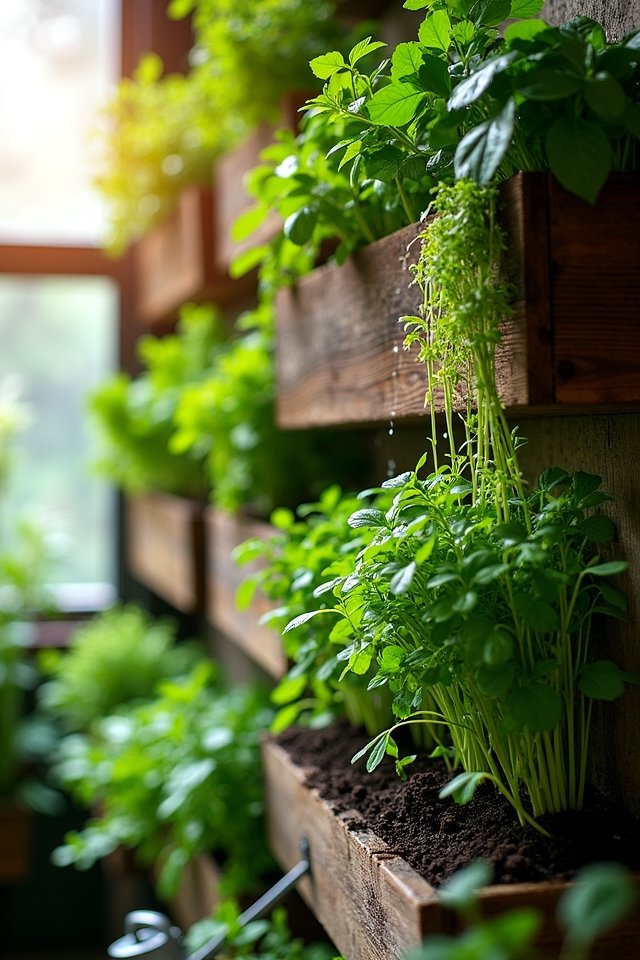
While you might think watering your vertical garden is a simple task, mastering effective techniques can elevate your green thumb game to superhero status! The secret lies in strategic watering that promotes moisture retention and guarantees ideal growth. Here are four innovative techniques to try:
- Drip Irrigation: Install a drip system for precise, efficient delivery right at the roots!
- Watering Schedule: Establish a routine to keep your plants consistently hydrated without drowning them.
- Moisture Meters: Invest in a handy gadget that tells you when your soil needs a drink—no guesswork!
- Mulching: Use organic materials to cover the soil, reducing evaporation and locking in moisture!
With these strategies, your plants will flourish like superheroes in their vertical urban jungle!
Maximizing Sunlight Exposure
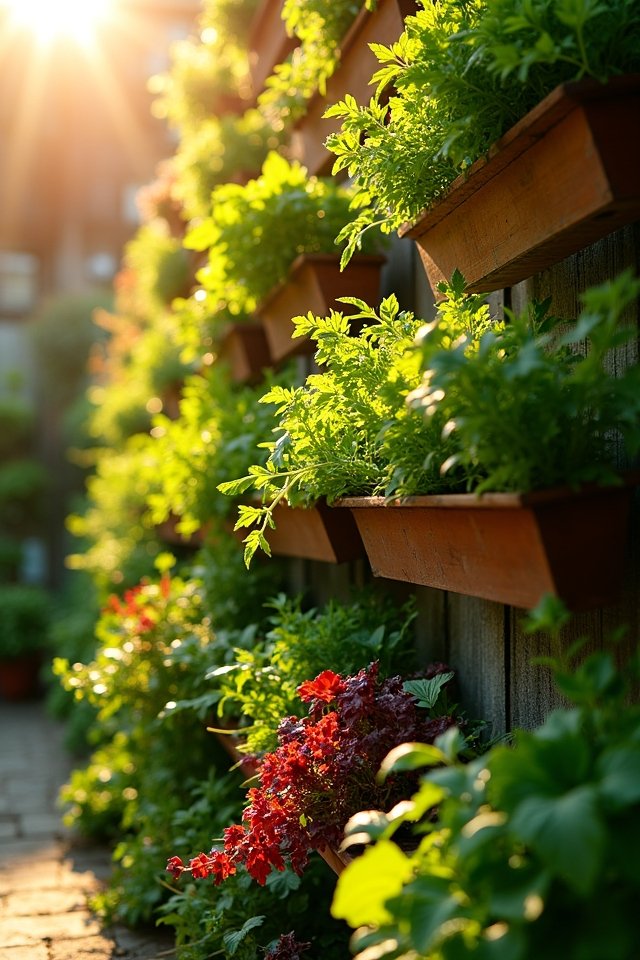
To truly release the potential of your vertical garden, you’ve got to get creative with sunlight exposure! Think of your plants as sunbathers sprawled out to soak in those glorious rays. Position your vertical containers to capture light angles throughout the day—South-facing walls are goldmines! You don’t want shadows playing hide and seek, so pencil in strategic spacing. Try rotating your setup every few weeks; it’s like sending your plants on a mini vacation! Use reflective materials behind your containers to amplify that lovely sunshine, making sure every leaf gets its fair share. Remember, the more hours your plants bask in light, the more vibrant and delicious your harvest will be! Are you excited yet? Let’s get that garden glowing!
Pest and Disease Management Strategies
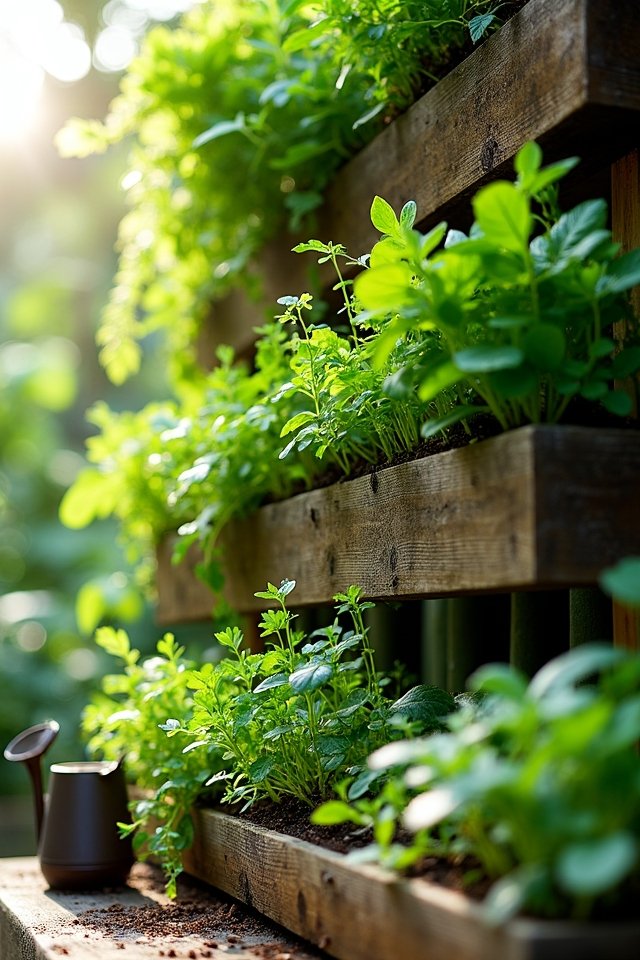
After basking in the sun, your plants might face a less pleasant reality: pesky pests and sneaky diseases lurking around! Don’t fret—let’s tackle these invaders with flair! Here are some innovative strategies to keep your vertical garden thriving:
- Use organic pesticides like neem oil, which works wonders against a variety of pests while being gentle on beneficial insects.
- Embrace companion planting—pair fragrant herbs like basil with tomatoes to mask their scent and confuse pests!
- Regularly inspect your plants for signs of trouble; early detection is key!
- Rotate your crops to disrupt pest lifecycles and rejuvenate your soil.
Seasonal Care and Maintenance Tips
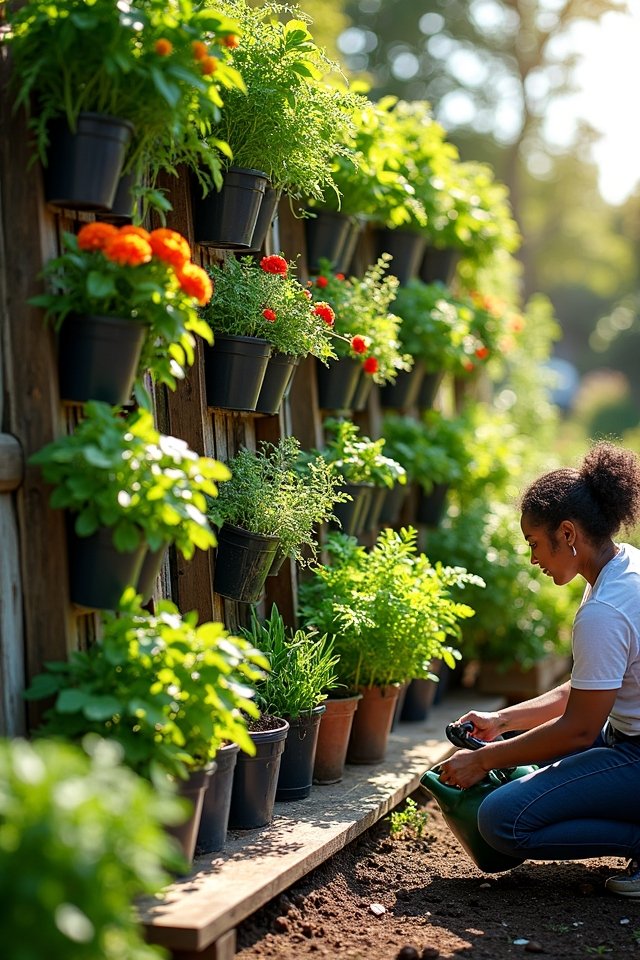
As you glide through the seasons, tending to your vertical garden becomes like a joyful dance, with each season bringing its own rhythm and style! Welcome seasonal planting by choosing vibrant flowers in spring and hearty herbs in fall. Don’t forget the temperature adjustments—some plants love the heat, while others thrive in cooler temps! Rotate your crops to keep soil fresh and nutrients high. In winter, snuggle your garden with frost covers. Watering schedules might shift, so stay attentive. Picture your luscious, fresh basil in summer; the aroma alone is a treat! Just like a well-timed dance move, responsiveness is key! So, are you ready to twirl and sway your way to a bountiful harvest?
Frequently Asked Questions
How Much Space Is Needed for Vertical Container Gardening?
When it comes to vertical container gardening, space is key! You don’t need a sprawling backyard; just a sunny nook will do! For container size, think about 12 to 24 inches in diameter. This gives roots enough room to dance! As for plant spacing, allow about 6 to 12 inches between plants, depending on their size. That way, everyone gets their sunshine and nutrients! It’s like a party—everyone needs personal space! 🌱✨
Can I Use Recycled Materials for Containers?
Did you know that about 22 billion pounds of recyclable food packaging end up in landfills each year? Upcycling containers turns trash into treasure! You can use old buckets, tin cans, or even wooden crates for your garden. Just make sure you drill some drainage holes to keep roots happy! Imagine colorful flowers spilling over a painted can! It’s creative, eco-friendly, and your garden will look like a whimsical wonderland! What’s not to love?
What Is the Best Height for Vertical Gardening Setups?
When setting up your vertical garden, aim for an ideal height that keeps your plants accessible! A height of about 4 to 6 feet works wonders—think of it like a towering cake, just the right size for a tempting slice. You won’t want to strain your back while picking those juicy tomatoes, will you? So, design your setup to make gardening a breeze, turning your space into a flourishing, vibrant oasis!
How Do I Prevent My Plants From Toppling Over?
To keep your plants from toppling over, focus on plant stability! Think of sturdy support systems as a strong backbone for your greenery. Use trellises, stakes, or even clever DIY solutions like repurposed bamboo. Imagine your plants standing tall like proud warriors! And hey, don’t forget to choose containers with solid bases. A little weight at the bottom keeps them anchored. Who wants a garden disaster, right? Let’s keep those plants upright and thriving!
Can Herbs Be Grown in Vertical Containers?
Imagine your vertical garden as a delightful herb symphony, where each plant plays its own tune! Yes, you can definitely grow herbs in vertical containers! Just think about herb compatibility—thyme dances gracefully with rosemary, while basil and parsley form a lively duet. Choose containers that provide good drainage, like breathable fabric pots. With the right setup, your herbs will flourish, creating a delightful aroma that whispers of culinary adventures! How exciting is that?
